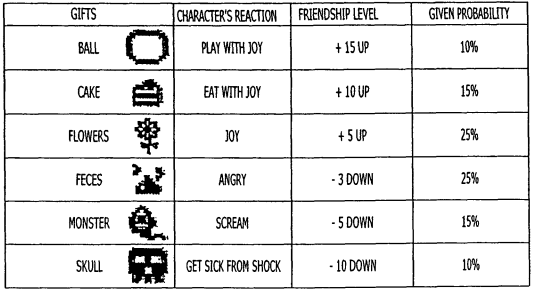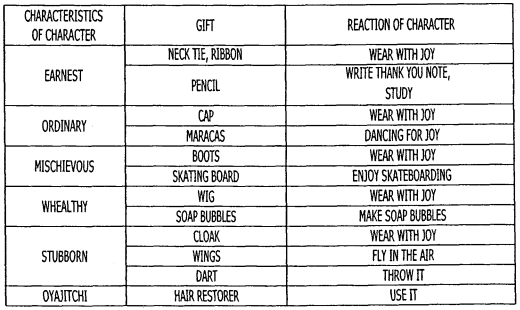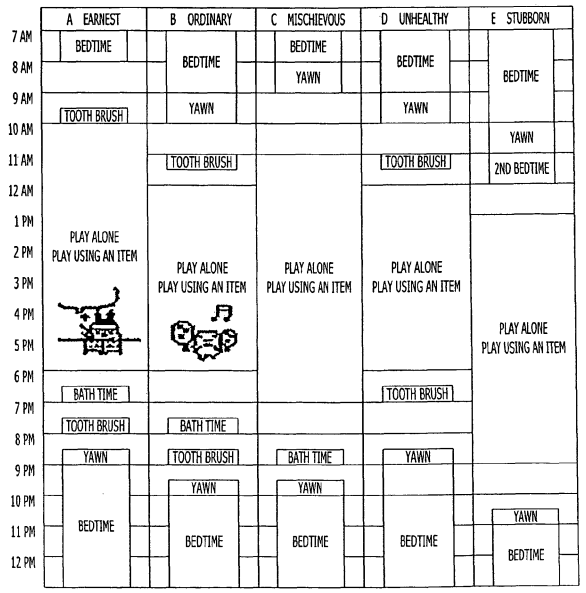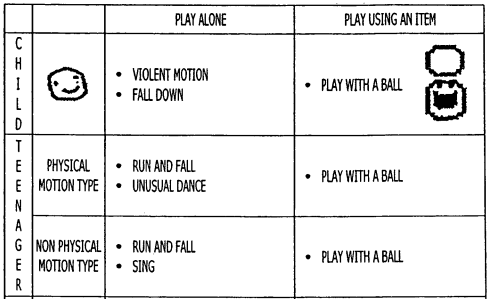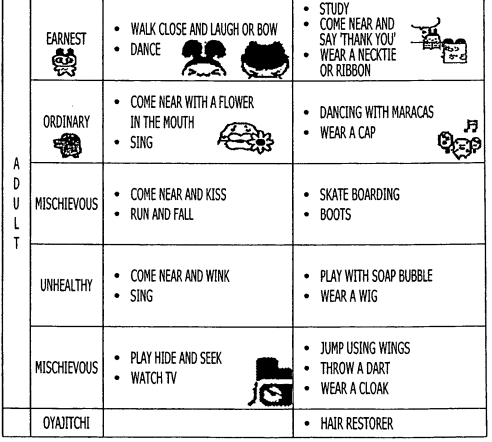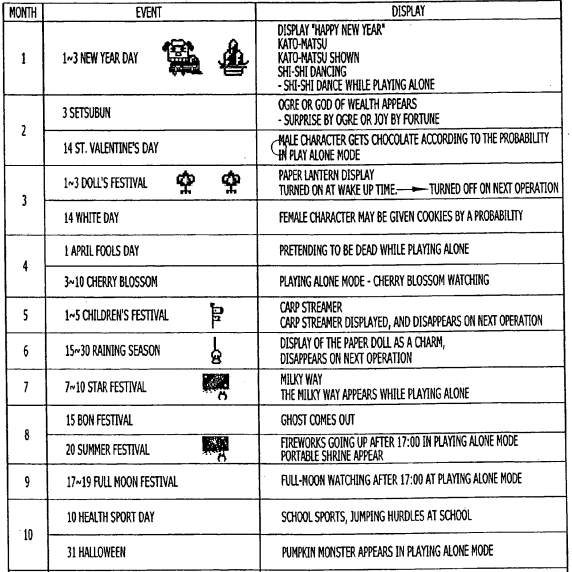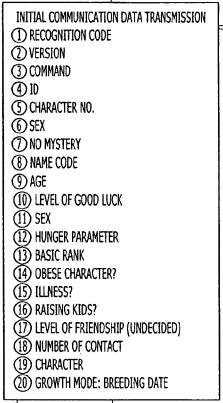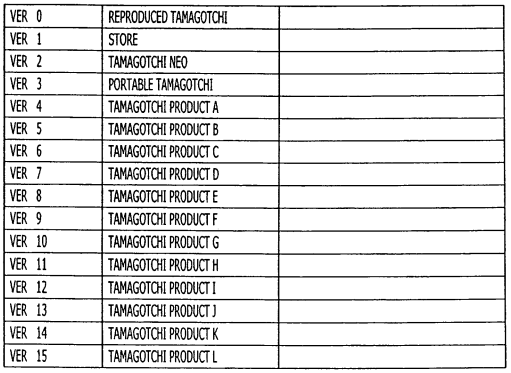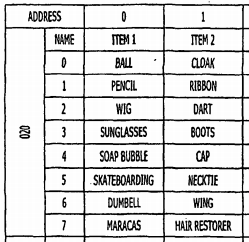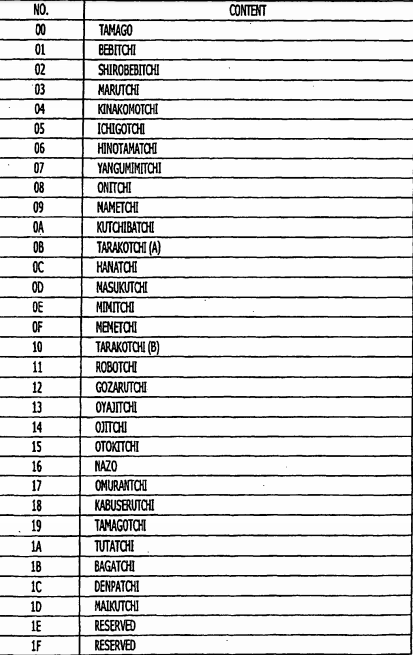Okay, I think it's finally time to talk about those patent documents for the V1. The patents are for a "Communication Game Device", one of the patents being in Japanese and the other apparently being a translated version of the Japanese document. As such, there are a few translation errors here and there, so I'll be checking both documents.
Both of the patent documents were files on December 26th 2003, a few months before the Japanese release of the Tamagotchi Plus. I'm not sure what stage of development the Tamagotchi was at at this point, but by the looks of it, most of the mechanics had been decided upon.
The document begins with a crude drawing of a Tamagotchi device.
The shape of the device and the location of the keyring more closely match the vintage models than the Connection-era devices. Instead of a window at the top, two small circles are depicted as allowing the IR functionality. Specifically:
The main body 1 has at the upper part an infrared light emitting device 17 which is a sender and the infrared light receiving device 19 which is a receiver and they enable communication with other communication game devices.
Skipping ahead to figure 3, we're greeted with a diagram explaining Tamagotchi growth:
The diagram mostly matches what we expect of the V1. Although the bottom of the diagram says "Grandfather" and "Grandmother", this seems to be a mistranslation of じいさん and ばあさん which also mean "Old man" / "Old woman". The right of the diagram names the five different character categories on the V1 - "Earnest", "Ordinary", "Mischievious" [sic], "Unhealthy" and "Stubborn".
At the top of the diagram we see one immediate difference - the egg sprite from the (Japanese) P1 is shown instead of the one the V1 uses, which is a modified version of the Mesutchi egg sprite. No teenagers are shown, possibly because all the teenagers on the V1 were entirely new.
Another diagram showing the character groups. Instead of describing the characters in terms of a single "care misses" parameter, each group corresponds to mental and physical wellbeing levels. Surprisingly, groups C and D are described as being "Ordinary mental wellbeing, poor physical wellbeing" and "Poor mental wellbeing, ordinary physical wellbeing" respectively, instead of D being described as worse care than C.
Figure 5 lists the different options underneath each menu, as well as some "hidden parameters":
These reflect the care parameters we saw before, as well as a device ID and some sort of "good luck" level.
Next we have a table showing the different variables in the first menu:
This confirms that there are an additional two hunger hearts and one happy heart that aren't seen to the player. It also gives an explanation of how care affects the level of physical or mental underdevelopment. Apparently the weight of the character decreases by 1 for every hour the character is left with 0 hunger too? That's something I wasn't aware of, if that's present in the final version.
There's some interesting text regarding the weight parameter:
At the breeding age, if the weight reaches 99 g according to the way meals are given, a picture is displayed showing the virtual living object is overweight. If the weight is reduced to 80 g after dieting by playing the mini game, a normal character is displayed. The program enables the control such that if the virtual living object becomes obese, the chance of the virtual living object getting sick increases and it becomes impossible for the virtual living object to have a meal, and the discipline mode will not be carried out.
Sounds similar to a mechanic that was used on the Osutchi and Mesutchi and later on the Tama-Go. I guess this was a cancelled feature.
Continuing on the topic of care misses, there's also this table explaining care misses further:
Apparently, each of the games has the effect of decreasing one of the care miss parameters if you play them enough. The wording is ambiguous here but it goes into more detail in another part of the document - clearing 20 or more hurdles is what decreases the care miss counter, not playing the game 20 times. The luck parameter is given in a little more detail, too - it seems to affect how well your Tamagotchi forms relationships with other characters.
In fact, there's a whole section on what seems to be an entirely different take on the matchmaker mechanic:
If the growth phase of the virtual living object comes to the "breeding age" and day one goes by, the "arranged dating" system becomes available. The "arranged dating" system is a command that executes a program in which the virtual living object gives birth to a baby having good luck of level 1 if the "arranged dating" is successful even if the player does not communicate with another game device. In the "arranged dating" system, the player chooses one of four virtual living objects and the arranged dating is successful if both virtual living objects are chosen who will fall in love with each other and a heart sign lights up and a baby is born. The game player can choose the partner up to 3 times per day, and the game player is supposed to choose an arranged marriage partner considering the personality of the character (virtual living object). The virtual living object can be chosen with the A button, and the character of the virtual living object can be displayed with the B button. The rate of successful arranged dating changes with the level of good luck. The rate is also increased by 20% if the virtual living object has an item. A "debuchara" (obese character) has no chance of having a successful arranged dating experience. If the "arranged dating" is successful, a baby may be born, but after childbirth, the life of the parent and the child lasts for three days (a picture showing the parents and the child is displayed), and the parent’s numerical value is displayed as a parameter.
If the good luck mechanic is unused in the final version of the device, perhaps the removal of this feature was responsible.
Ever wanted to learn more about Tamagotchi poop? Well, now's your chance:
The "(3) toilet" command is to delete a picture representing excrement on a display a certain period of time after the virtual living object has a bowel movement. The program enables the control such that if eight excrements are shown on the display, the virtual living object gets sick (cannot eat meals or snacks or the game can no longer be played). Whenever the hunger parameter decreases by two, the virtual living object has one bowel movement.
Yeah, that first line really makes me laugh, too.
The document then goes on to explain the connection feature and an entire ranking system that's used to determine which character wins and which loses - I won't go into too much detail about this here though. The text very quickly cuts off here and switches to repeating what was already said, but in German this time. The Japanese document continues, though I can't guarantee the accuracy of Google Translate's take on this section:
In the case of "Ren-ai", the opposite aircraft communicated was heterosexual after 1 day of the spawning season.
Okay yeah this section is going to be an absolute nightmare to understand. Not to worry though - as I was writing this I realised I've been looking at the European version of the document, and the US version of the document was the one I had been looking at previously - for some reason, it contains more information than this one does.
Continuing on the topic of IR connection, the document makes the following claim about connection breeding:
This process is different from the "arranged dating process" using icon (4) "minigame"
So apparently that early matchmaker game mentioned earlier was literally in the game menu.
Pictures show the result of connection breeding, as well as the effect it would have on the luck level of the child:
Both the image and the text claim that both a boy and a girl are born, obviously contrasting from the final version. The animations seem pretty different, too!
Here's an interesting bit about recording friends:
Every time ten friends are listed as a result of various communications, an image showing a congratulations banner is displayed, and a special cake which is not served on normal occasions is served. The special cake refers to Snacks which can be eaten bringing the 'good mood' parameter to the top without increasing the weight.
I'm definitely not convinced this is a feature in the final version, unless they removed this in later versions and my V1-experience is just really limited.
This next bit is particularly interesting:
The communication game device of the present invention is capable of storing items “the gift given by the friend by communication' and items “the gift received in the seasonal event”under“a gift (item)” (See FIGS. 11A and 11

, and the given gifts can be used.
There's never any mention of any sort of seasonal event item in the figures. In fact, the figures show the following:
Note also here that the sprites for the ball and the flower are different from their final versions.
On the third day of the parent-child mode display at about 12 o'clock midnight, the parent disappears (implying separation of the parent from the child (leaving a nest)). Under this circumstance, if the power is on, the pictures will be displayed for this situation.
Interestingly, this passage seems to suggest that the parent death sequence is only visible if the lights are on. This changed in the final version.
Ever wondered how death works?
The conditions which satisfy the state of "seriously ill" include those cases where the virtual living object is neglected for 12 hours with the hunger parameter being 0, where the virtual living object is neglected in a state of being "seriously ill" for 12 hours, where the virtual living object gets sick four times during a single growth stage and where three days have passed after the "ojitchi" or "otokitchi" is displayed.
It seems like this last bit suggests that originally the Tamagotchi would have died three days after becoming an old timer? Perhaps it does that on the Osutchi and Mesutchi?
The next section describes the different animations that play throughout the day. We get this lovely timetable showing each character group's actions:
If some of the characters really do have a nap after waking up, I wasn't aware of it.
In "playing alone/play with an item', a picture is displayed based on a 50% probability after a lottery is performed once every 15 minutes during childhood. The pictures displayed in the event include five kinds of play including “play with an item'. A decision on which picture is displayed is made as follows: for the first five showings, a picture is chosen which has never been displayed. For the sixth and further showings, a picture is chosen randomly from the five previously shown pictures. As a teenager, the lottery is performed once in every 30 minutes and a picture is shown with a 50% probability. A picture is shown following the order of priority of a “seasonal event”, “play with an item', and “playing alone'. After all the different kinds of "playing alone/play with an item' have been shown, a picture is chosen randomly from all of the different kinds of pictures. A list of pictures displayed in the “playing alone/play with an item” modes is shown in FIG. 16. As seen from the list, different pictures are displayed at different stages such as childhood, teenager and adult.
"Seasonal events" are mentioned again, referring to the animations that play on specific dates throughout the year. Here's the animation list they mentioned:
Marutchi is once again shown with a different ball sprite and - what's this? The vintage version of Masukutchi was apparently planned to feature on the V1, and we get a nice sneak peak of his close-up animation! It's likely that Masukutchi was replaced with the identically named Connection-era character. Kind of a shame, honestly. Kuchipatchi's close up sprite seems to have been subtly modified, too.
The seasonal animation list is as follows:
As far as I'm aware, the only seasonal events on the plus are New Year, Doll's Festival, Children's Festival, Star Festival, Full Moon Festival and Christmas.
The text goes into a lot more detail about each of these, but I'll pick out the more important bits:
On "St. Valentine's Day', February 14, pictures showing a male character having chocolate as a gift from a friend are displayed to commemorate the day or pictures showing a male character having chocolate are displayed at the time of the “playing alone' mode based on the probability of the level of good luck.
On “White Day', March 14, a picture showing a female character having a cookie as a gift from a friend is displayed to commemorate the event. During the playing alone” mode, the female character can get a cookie using a probability based on their level of good luck.
On April Fool's Day”, April 1, a picture showing a character pretending to be dead is displayed at the time of the "playing alone” mode to commemorate this day.
During April 3-10, in the "playing alone' mode, a picture showing a cherry blossom viewer is displayed.
During June 15-30 when the rainy season sets in, a picture of a paper doll is displayed at wake-up time to wish for fine weather (it disappears if another action is taken).
On August 15-17, a picture showing a ghost is displayed as an event of the “Bon Festival' during the “playing alone' mode. On August 20, a picture showing “exploding fire works’ is displayed in the “playing alone” mode time after 17:00 as an event of the “Summer Festival” and a picture showing "carrying mikoshi' is displayed during the “playing alone” mode time.
On October 10, “Health Sports Day', a picture showing a hurdle competition is displayed during the playing alone” mode as the event of the season.
On October 31, a picture is displayed showing a “pumpkin monster” for “Halloween during the “playing alone' mode.
On November 15, a picture is displayed showing a 3 year old, 5 year-old, and 7 year-old virtual living object (Tamagotchi) getting a gift at wake-up time to celebrate the “Shichi-go-san' holiday.
The countdown for the New Year starts 5 seconds before the New Year, and the numbers 5, 4,3, 2, 1, are displayed, and a picture showing “Happy New Year” is displayed.
Next, we get lots of diagrams explaining the connection process, as well as this
lovely picture of Mimitchi doing... something
The following values are identified as information that is sent during connection:
Once again, identifying the most important parameters:
The “recognition code” is a code for the recognition of the device expressed in 8 bits. The recognition code identifies the difference in the hardware configuration. For example, the communication game device of the same hardware configuration has the same recognition code, but a communication game device of a different hardware configuration has a different recognition code even if the game device can communicate with the game device having a different code.
The "version" is information expressed in 8 bits which varies depending on the kind of character picture (picture of the virtual living object) to be displayed, or the relationship between the memorized character picture and the picture ID.
The “command” is information expressed in 8 bits according to the communication currently performed. In the case of the initial communication process, a code of the “initial communication" is set for the sending game device and a code of an “initial communication response" is set for the receiving side.
The "ID" is the information (body ID) which a calculation processing section gives randomly at the time of reset (Such as at the time the battery is exchanged, etc.) to a communication game device using a number selected from 0 through 256 based on the control program. The information is used in combination with the “name code" explained below in order to identify a partner's communication game device.
The “character number is expressed in 6 bits and is given to each of the various virtual living objects as a code (picture ID). About 35 different codes are provided.
The “no mystery' is one-bit information. The code takes “0” which is defined as “mysterious” when the “version” information sent from the communication partner (picture code) is different from the “version of the player's game device. However the code takes “1” which is defined as "no mystery' when the “version' information sent from the com munication partner (picture code) is the same as the “version' of the player's game device.
The “hunger parameter is a three-bit parameter which affects the result of “quick-eating competition'.
The “number of encounters' increases by one every time communication is performed with the communication partner already remembered in the communication partner memory part.
After the initial communication process, the sending game device checks the received “recognition code” and the “version' to confirm that the receiving game device is able to communicate with the sending game device.
This also explains why a device with ROM version 2.0, upon connection with a debugged V1 showing V2 characters, will display the character icons as a random mess of pixels - the version number matches what the device is expecting, so the "No mystery" parameter is set to 1. However, as the 2.0 lacks the data for these characters, the necessary data is not present within the list of character sprites, so garbage data is displayed visually instead.
In fact, another paragraph later on in the document confirms this!
If the information on the “version' (memory picture code) exchanged in the initial communication process is identical on both sides, the character picture in accordance with the “character number obtained in the initial communication process is fetched. If the information on the “version' is not identical on both sides, the kinds of character pictures memorized in the image storage section may differ, or the character pictures may differ even if these pictures have the same "character number. In those case where the “version of the sending device and the receiving device are found to be different after the “version of a communication partner and the player's game device were compared, the communication game device of the present invention displays the “mystery mark' having the character number 16' indicating that the memory picture code is not identical. When the “memory picture code of the communication partner who communicates for the first time differs from the “memory picture code' of the player's game device, the “no mystery' parameter for the communication partner is set to “0” (i.e., “mystery’) in the steps of “add or renew memory” processing in the “add/renew memory’ process. After this setting, when the friend list is displayed, the “mystery mark” of a character number 16' is displayed as the virtual living object of the communication partner.
This next line is of particular importance:
In the case where the Step S12 shows that the partner device can communicate with the player's game device, a decision is made in the next step (Step S13) whether the communication partner’s “recognition code' is a 'store code'. The “store code” in the “recognition code” is used only for a communication game device installed in a store which is able to communicate with a communication game device. By the decision process, it is decided that the communication partner is a device installed in a store and the process shifts to the “store communication process' shown in FIG. 31 (Step S14).
(The figure isn't very interesting, please take my word for it). This section briefly describes the process behind recognising a device as a Deka device - it doesn't go into any more detail about the Deka features here, though.
After an incredibly hefty section about how games and gifts are decided upon, the Deka is returned to once more:
The “recognition code” refers to information for identify ing the device which serves as a communication partner. As shown in FIG. 33, the information includes 15 items denoted as VER 1-VER 15. If the “recognition code” is VER 1, the device which received the “recognition code' recognizes that the communication partner is a device installed in a store.
The "Recognition code" should probably start ringing some bells now - it's the ROM version!
Most of this table is completely redundant. Let's take a look at each of the devices that are named:
"Reproduced Tamagotchi" - The Japanese document says "Reprint" instead of "Reproduced". This probably just refers to the fact that Tamagotchi Plus is a "return" of Tamagotchis (かえってきた!) and it corresponds with the Plus's version number, 0.0.
"Store" - Deka Tamagotchi. I guess we can be pretty confident that the Deka has a version number of 1.0!
"Tamagotchi NEO" - 2.0 corresponds to the Connexion, so perhaps this is an early name for the Tamagotchi Connexion, and perhaps the Connection too.
"Portable Tamagotchi" - 3.0 actually corresponds to the unused English Deka, but it's very possible that plans for which versions would correspond to each version number changed this early in development. In fact, the Japanese document instead says "Keitai Tamagotchi" - apparently, they had plans for the Keitai this early in development.
The “device installed in the store' is a device installed in a store which is capable of communicating with the communication game device of the present invention. The device installed in a store is provided with functions and information which are not given to the usual communication game device. The pictures to be displayed and the various programs performed after the “device installed in the store' and the communication game device of the present invention communicate with each other are memorized beforehand in the communication game device. These pictures and programs are appropriate for the “device installed in the store' and are not displayed or performed until the communication game device acquires the “recognition code’ VER 1 in the initial communication process.
This next paragraph seems to suggest that the original friend list cap was 20 and that data from the list would delete itself:
If the number of communication partners exceeds 20, the information is added based on the new communication and the information about one of the communication partners who has already been memorized based on the predetermined conditions is deleted.
That's it for the huge wall of text in the document. There's still a couple fun figures to look at though!
If you've ever wanted a list of item ID numbers, here's some sort of table for you.
And how about character IDs? A few of the names are a little bit corrupted, but the Japanese document gets them all right. The IDs perfectly match up with the order the characters appear in the debug list - that means we can give names to two characters who were previously ambiguous!
The character previously known as "Tsutayatchi" - named after Tsutaya, the company whose logo it is based upon - is actually called "Tsutatchi" (perhaps it received both names?). And remember this little nameless "three blocks" character that was originally intended to be a Deka character? The one that kind of looks like a phone signal and sends you text messages when you connect with it?
It's actually called Denpatchi! This makes a lot of sense, as "Denpa" can mean "Radio Wave" (mobile phones actually communicate with microwave radiation, but whatever).
Oh, and Tarakotchi appears on here twice. If you've ever wondered why he appears twice in the debug list, it's because the first one is for odd generations, and the second is for even generations.
I think that's about enough of this document - it's 2:00 am and I've found about as much as I can. My fingers have had enough. I hope you've all enjoyed reading! If you want to read more for yourself, here's a few links to the patent pages and the respective documents:
US Patent
https://patents.google.com/patent/US8545324B2/
https://patentimages.storage.googleapis.com/8f/7a/0a/aa530ac17e133b/US8545324.pdf
JP Patent
https://patents.google.com/patent/JP3702283B2/
https://patentimages.storage.googleapis.com/ba/10/22/91e25bf8c51100/JP3702283B2.pdf
EU Patent
https://patents.google.com/patent/EP1557211B1/
https://patentimages.storage.googleapis.com/94/fb/d2/8b1ba2d7e781ac/EP1557211B1.pdf
Thanks for reading!




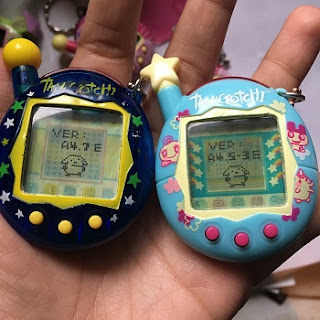
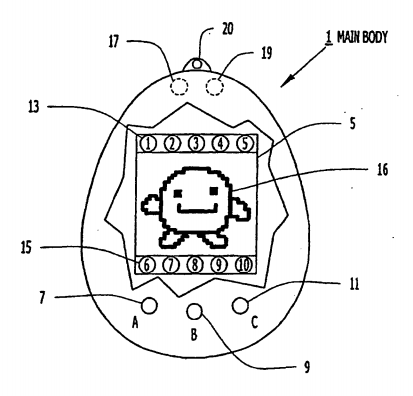
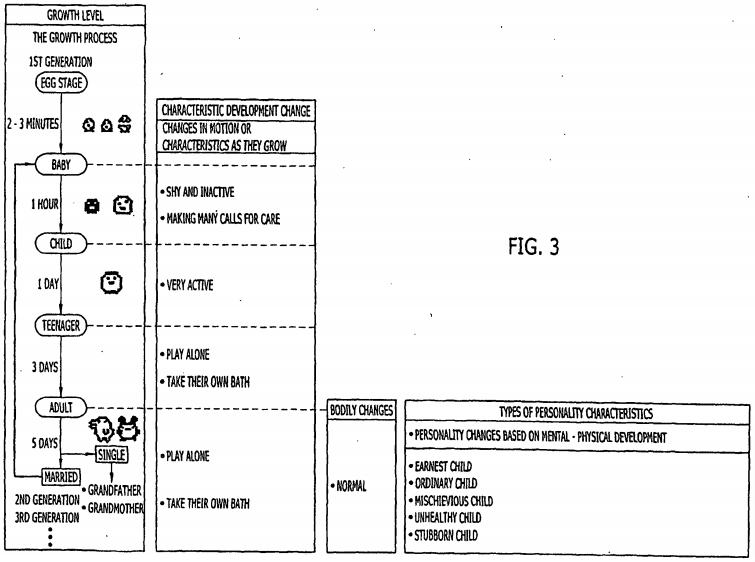
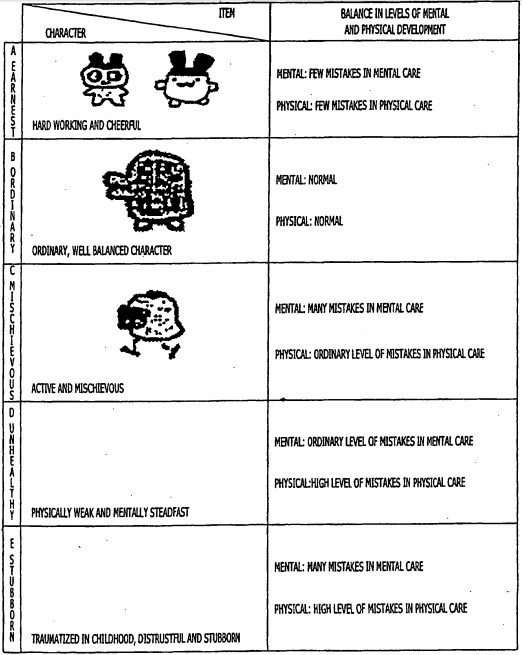

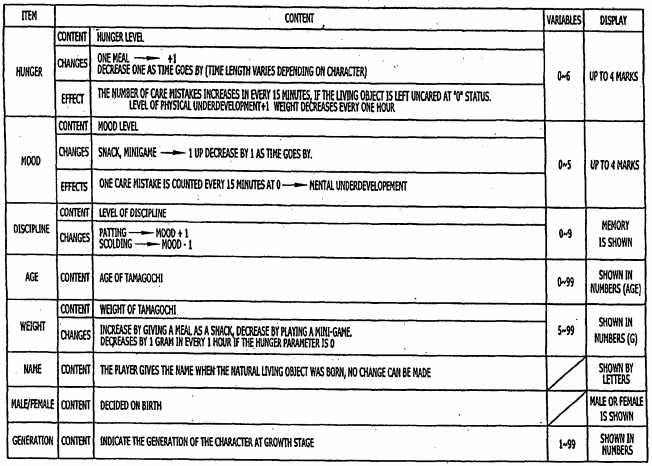
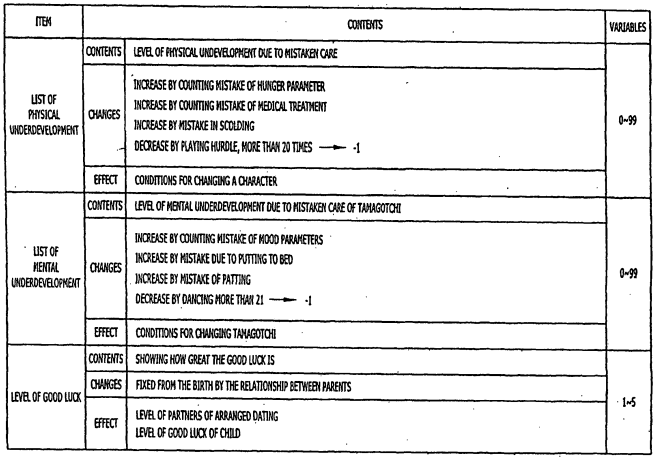
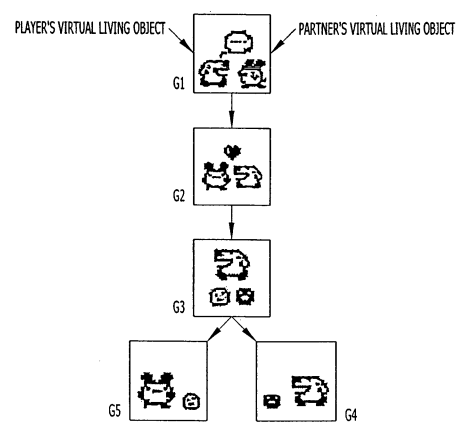
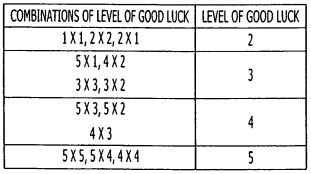
 , and the given gifts can be used.
, and the given gifts can be used.
